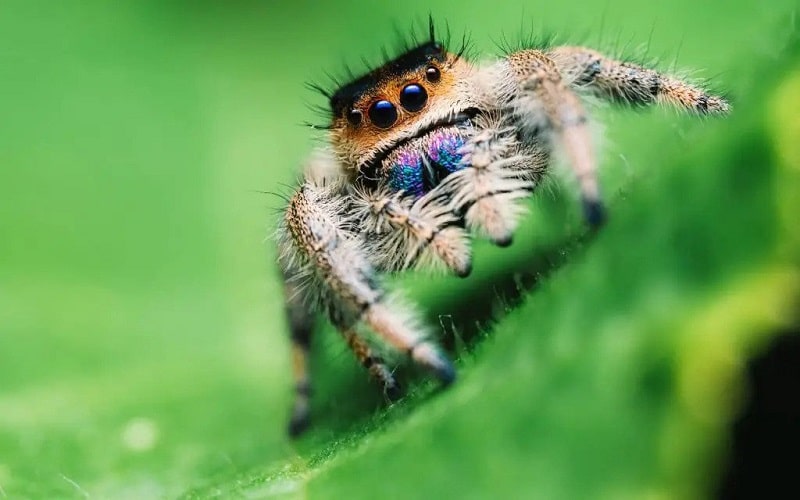When you see a tiny creature jumping from leaf to leaf in your garden, it’s likely a jumping spider. These agile creatures have fascinated humans with their acrobatic antics, but what do they feast on?
Let’s delve into the world of the jumping spider diet to discover what jumping spiders eat.
What Do Jumping Spiders Eat (Main Food For Jumping Spiders)
The primary diet of jumping spiders is primarily composed of insects, but they aren’t very picky eaters. They’ll also happily gobble up other spiders, supplementing their diet with whatever tasty morsel they can snag.
Jumping spiders are not vegetarians. They rely on protein from various insects and other small creatures. These tiny creatures form the core of the jumping spider diet. In particular, they love munching on flies, mosquitoes, small moths, and even other smaller spiders.
But what’s even more interesting is their occasional taste for vegetarian cuisine. Yes, you heard that right. Even though they primarily eat meat, they have been known to enjoy plant matter and nectar, breaking the stereotype of spiders being strict carnivores.
This surprising aspect of jumping spider food consumption shows us how diverse and adaptable these tiny creatures can be.
Jumping Spiders’ Prey Include:
- Green bottle flies
- Fruit flies
- Wax worms
- Other spiders
- Wasps
- Moths
- Bees
- Butterflies
- Katydids
- Worms
- Crickets
- Mealworms
- Fly larvae
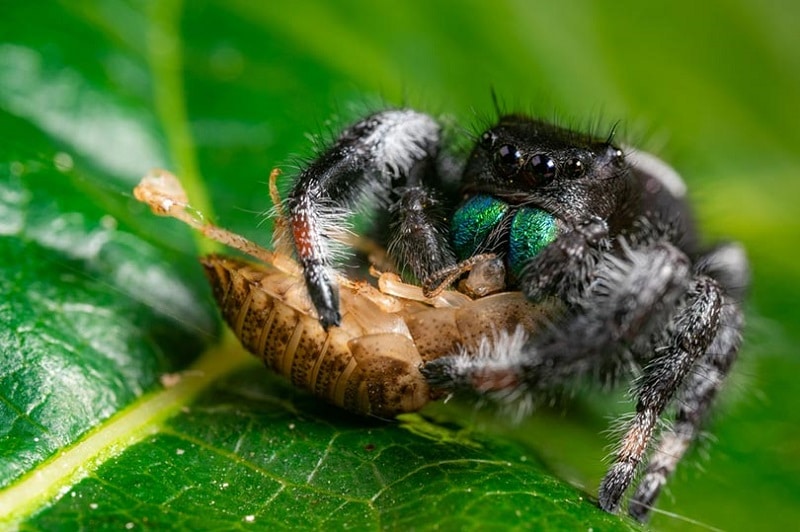
How Do Jumping Spiders Hunt?
Jumping spiders have a unique hunting method that sets them apart from other spiders. Rather than spinning a web and waiting for their prey to get trapped, jumping spiders actively hunt down their food.
Their hunting technique involves stalking their prey from a distance before making a sudden and rapid leap to snatch up their meal. This is where their name, ‘jumping spiders’, comes from.
Jumping spiders have excellent vision, thanks to their large eyes. They use this keen sight to locate and stalk their prey. Once they spot a potential meal, they slowly and stealthily approach. And then, with a swift and accurate jump, they pounce on their unsuspecting prey.
The process of jumping spiders eating is both fascinating and chilling. They immobilize their prey with venom before enjoying their meal. This venom is not harmful to humans, but it’s quite effective at taking down their food.
Remember, the diet of a jumping spider can vary depending on their habitat. The jumping spider diet in a garden may include more plant-eating bugs, while a house-dwelling spider might snack on flies or mosquitoes.
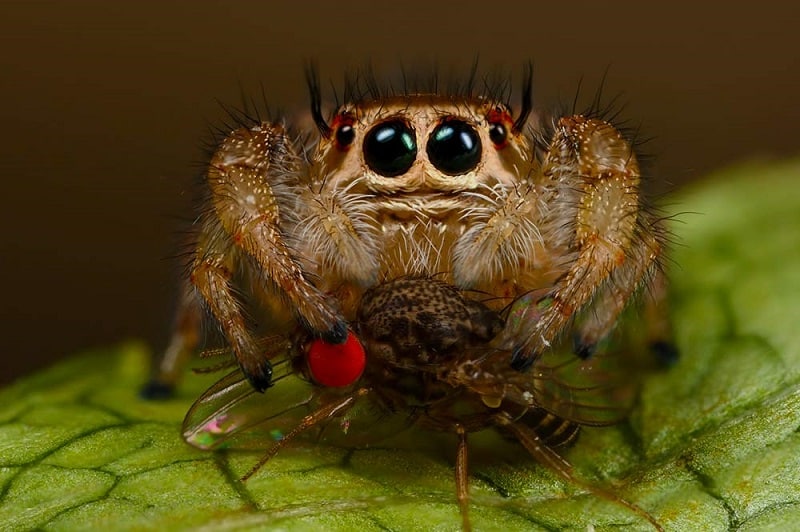
How To Feed A Jumping Spider
If you’ve got a pet jumping spider or are just curious about how to provide for one, it’s important to understand their diet and feeding habits. But what does the jumping spider eat in a domestic setting? The answer is similar to their wild counterparts.
In captivity, a jumping spider’s food can include a variety of small insects. Feeding them flightless fruit flies, pinhead crickets, or small mealworms are all great choices. You can find these at most pet stores. Just make sure the prey is not larger than the spider itself.
As for the ‘how’, it’s quite simple. Place the prey inside your spider’s enclosure and watch it do the rest. Jumping spiders have keen eyesight and are excellent hunters, so they’ll spot the food you’ve provided quickly.
While they can also eat small bits of plant matter, it’s important to know this should only be a small portion of their diet. The majority of a jumping spider’s diet should come from insects and other small creatures.
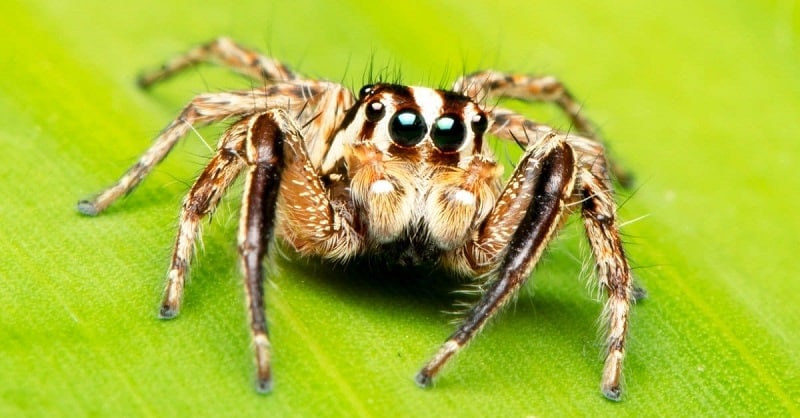
How Often Do Jumping Spiders Eat?
Knowing what does jumping spiders eat is just one part of the equation. Understanding the frequency of feeding is equally essential. The answer, however, can vary based on the spider’s size, age, and overall health.
Typically, adult jumping spiders eat every two to three days, while younger spiders, given their faster metabolism and growth, need to eat daily. But don’t worry if your spider doesn’t eat on this exact schedule. Jumping spiders, like many creatures, have their rhythms, and sometimes they might not be hungry when you expect.
Remember, overfeeding can be as harmful as underfeeding, so it’s vital to find a balance. If your spider doesn’t seem interested in food, it’s best to remove the uneaten prey and try again the next day.
What Do Baby Jumping Spiders Eat?
Just like adults, baby jumping spiders, often referred to as ‘spiderlings’, are carnivorous and start hunting almost as soon as they’re born. However, given their smaller size, their diet comprises smaller prey compared to their adult counterparts.
Spiderlings typically feast on tiny insects or arthropods, like fruit flies or micro crickets. Anything small enough for them to capture and eat is fair game.
What’s interesting is that spiderlings display the same remarkable hunting behaviors as adult jumping spiders from a very early age. Even at their small size, they’ll stalk and pounce on their prey with surprising agility and precision, making them tiny but formidable predators.
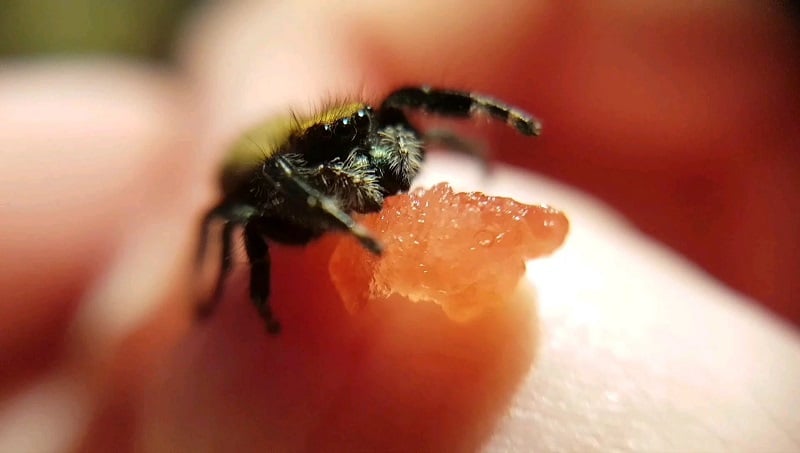
Importance Of Understanding Spider Diet
You might be wondering why it’s important to know about jumping spider food or what do jumping spiders eat. Beyond mere curiosity, understanding a spider’s diet has significant implications in several areas.
For starters, it helps in pest control. Jumping spiders play a vital role in managing pest populations, like flies and mosquitoes, in and around our homes and gardens. By understanding their diet, we can appreciate and promote their role in maintaining a balanced ecosystem.
For those with pet spiders, understanding their diet is critical for their care. Providing the right food and feeding them at the right intervals is essential for their health and longevity.
Moreover, understanding a spider’s diet can also contribute to scientific research and biodiversity studies. It helps us understand food chains, predator-prey relationships, and ecosystem dynamics. For instance, changes in a spider’s diet can indicate changes in local insect populations, serving as a bio-indicator of ecological health.
The diet of a spider is a small thread in the web of life, but it holds significant information. So, whether you’re a spider enthusiast, a pet owner, or a student of nature, knowing what do jumping spiders eat can open up a world of understanding and appreciation for these tiny creatures and the roles they play in our world.
Why Won’t My Jumping Spider Eat?
If you have a pet jumping spider that refuses to eat, it can indeed be a cause for concern. But don’t panic. There could be several reasons why your spider isn’t eating, and understanding these can help you care for your pet better.
One common reason is that your spider might be about to molt. Molting is a process where spiders shed their old exoskeleton to grow, and during this time, they often refuse food.
Another reason could be stress. If you’ve recently changed their habitat or if there’s too much activity around them, they might stop eating. Try to keep their environment calm and consistent to alleviate this stress.
Finally, the issue could simply be the type of food. Like humans, spiders can be picky eaters too. If your spider is not eating, you might want to try different types of insects to see if they have a preference.
In case your spider continues to refuse food for an extended period, it might be best to consult a vet or a local arachnid expert.
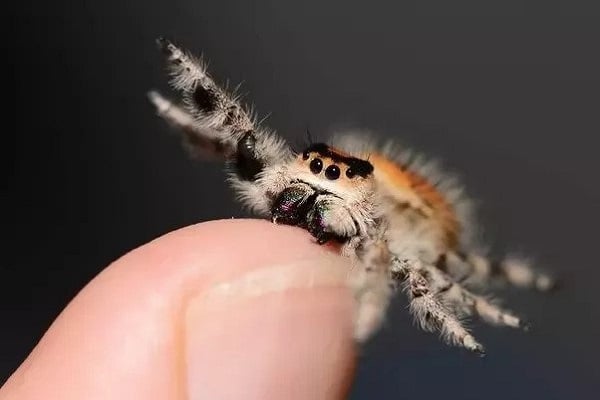
FAQ For Jumping Spider Diet
Will Jumping Spiders Eat Dead Insects?
While it’s true that jumping spiders eat a variety of insects, they generally prefer their food to be alive. This preference is primarily because jumping spiders are hunters that rely on movement to detect their prey. A dead insect might not catch their attention in the same way a live one would. However, some pet jumping spiders might accept dead prey, but it’s generally better to provide them with live insects to simulate their natural hunting behavior.
Do Jumping Spiders Eat Ants?
Yes, jumping spiders can and do eat ants. However, it’s important to note that not all ants are suitable prey for jumping spiders. Some ants, particularly larger ones or those with strong defenses like stings or formic acid sprays, can pose a risk to the spider.
Additionally, while ants can form a part of the jumping spider diet, they should not be the sole component. A varied diet including different types of insects will ensure your spider gets all the nutrients it needs.
Do Jumping Spiders Eat Rolly Pollies?
Yes, jumping spiders can eat small isopods like ‘Rolly Pollies’, also known as pill bugs. However, these creatures might not be their first choice due to their hard outer shell. The spider’s ability to eat them often depends on the size of the spider and the size of the pill bug. Larger, more mature spiders are more likely to be able to handle such prey.
How Long Can Jumping Spiders Go Without Food?
Jumping spiders can surprisingly survive for quite a long time without food. Some species are known to go without food for up to a month, while others can manage for a couple of weeks. However, this does not mean they should be starved for such periods. Like all creatures, jumping spiders need regular meals to stay healthy, energetic, and to grow properly.
Do Jumping Spiders Eat Other Spiders?
Yes, jumping spiders have been known to eat other spiders. In fact, they are considered one of the most likely spiders to exhibit this behavior, which is known as araneophagy. This behavior often depends on the sizes of the spiders involved, with larger jumping spiders more likely to prey on smaller spiders.
Do Jumping Spiders Eat Fruit?
Jumping spiders have been found to occasionally supplement their diet with non-meat items such as nectar or plant matter. But it’s important to note that these items make up a very small percentage of their overall diet and should not be considered a staple. Their primary source of nutrition comes from their carnivorous diet of insects and small invertebrates.
Do Jumping Spiders Eat Aphids?
Absolutely, jumping spiders will eat aphids. In fact, aphids can be a primary component of their diet, especially for jumping spiders that inhabit gardens and fields. Aphids are small and relatively easy to capture, making them a perfect meal for these agile hunters.
In this way, jumping spiders provide a valuable service for gardeners, as they help control the population of aphids, which are common pests that damage plants. So the next time you see a jumping spider in your garden, remember they’re there to help!
Do Jumping Spiders Eat Mealworms?
Yes, jumping spiders do eat mealworms. These worms are a favorite among many spider species, including jumping spiders, due to their size and nutritional content. However, it’s important to ensure that the mealworms aren’t too large for your jumping spider to handle.
If you’re feeding a pet jumping spider, it’s often best to provide them with ‘mini’ mealworms, which are smaller and safer for them to eat. Remember to offer a variety of food to your spider, not just mealworms, to ensure a balanced diet.
Do Jumping Spiders Eat Mosquitoes?
Jumping spiders are quite adept at capturing and eating mosquitoes. The size and flight speed of mosquitoes make them suitable prey for these spiders.
When a mosquito flies within range, a jumping spider can pounce with incredible speed and accuracy, snatching the mosquito right out of the air. So, apart from being a fascinating pet or garden companion, jumping spiders also serve as a natural form of mosquito control!
Can Jumping Spiders Eat Dubia Roaches?
Yes, jumping spiders can eat Dubia roaches, but with a few caveats. The size of the roach matters significantly; it must be small enough for the spider to subdue. For small or young jumping spiders, Dubia roaches may be too large and difficult to handle, so they’re generally better suited for larger, mature spiders.
Additionally, you should ensure that any Dubia roaches fed to your spider are not contaminated with any pesticides or chemicals, as these could harm or even kill your spider.
Can Jumping Spiders Eat Isopods?
Yes, jumping spiders can eat small isopods. Isopods, such as the common woodlouse or “pill bug,” are small enough for most jumping spiders to tackle. However, their hard exoskeleton can sometimes present a challenge, especially for smaller spiders or spiderlings.
It’s important to note, though, that like all creatures, spiders can have their preferences. Some might readily eat isopods, while others might prefer different prey.
Can Jumping Spiders Eat Wax Worms?
Yes, jumping spiders can eat wax worms. Wax worms are soft-bodied and small, making them an excellent meal option for jumping spiders. They are also high in fat, which can be beneficial for your spider, especially during or after molting when they need extra energy.
However, as with all food items, variety is crucial. Feeding your spider only wax worms can lead to nutritional imbalances, so it’s best to provide a range of different insects.
Do Jumping Spiders Eat Moths?
Yes, jumping spiders will readily eat moths, and their excellent hunting skills make them adept at catching these quick, flying insects. The jumping spider’s incredible speed and accuracy, coupled with its excellent vision, allow it to snatch moths right out of the air.
What Do Jumping Spiders Eat Most Commonly?
The jumping spider diet consists mainly of small arthropods. The most common items include flies, ants, small beetles, aphids, and other small spiders. However, the specifics of their diet can vary based on their size, age, and environment.
For instance, in a garden setting, a jumping spider might feast mainly on aphids and other small pests, while in a more urban setting, they might eat more flies or ants. Regardless, they’re opportunistic hunters who will eat a variety of prey as available.
How Does The Diet Of A Jumping Spider Vary By Location?
The diet of a jumping spider can vary significantly based on its location. For example, jumping spiders that live in garden or field environments might eat more plant pests like aphids or beetles, while those in more urban or indoor environments might eat more flies or ants.
Similarly, spiders in forested environments might eat a variety of small invertebrates, while those in more arid locations might rely more on ants or other hardy insects. The diversity of the jumping spider food source is a testament to their adaptability and survival skills.
What Role Does Human Activity Play In The Diet Of Jumping Spiders?
Human activity can play a significant role in the diet of jumping spiders. For instance, in urban or suburban environments, the availability of certain types of insects might be higher due to human activity. Garbage bins or outdoor lights can attract a variety of insects, providing an ample food source for these spiders.
Conversely, the use of pesticides can drastically reduce the number of available prey for spiders, potentially affecting their health and survival.
In summary, what do jumping spiders eat is influenced by a range of factors, from their natural environment to the impact of human activity. Understanding this can provide valuable insights into their behavior and help us ensure their conservation.

Calina Mabel has over 15 years of experience in the field of journalism and communications. Currently, Calina Mabel is the Content Writer for categories such as Cockroach, Ants, Bed Bugs, Mosquito, Rodent, Termite, and Flies on Pestweek.com. She aims to build content for these categories with a focus on providing valuable and accessible information to readers, in order to create the world’s largest knowledge community about Pests.
All content written by Calina Mabel has been reviewed by Emily Carter.


